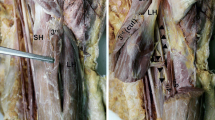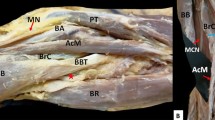Abstract
Variations appearing in biceps brachii muscle are common with accessory head, different origins, variant insertion, and different pattern of nerve innervation. However, variations appearing in both origin and insertion, and with other anomalous morphology at the same time are seldom. Here we report a complex variational case on the right arm of a 91-year-old Japanese female cadaver. The complex variations included (1) the biceps brachii muscle bifurcated at its distal ending; (2) the long head had its own tendon, which divided into two parts, i.e., a lateral part fused into the fascia between the brachioradialis and extensor carpi brevis, and a medial part attached to the radius about one centimeter ahead of the radial tuberosity; (3) the short head had an accessory origin from the shoulder capsule; (4) the bicipital aponeurosis was of two parts with an anterior superior layer formed by the long head and a posterior deep one formed by the short head; (5) the musculocutaneous nerve was especially underdeveloped that only innervated the coracobrachialis; (6) the existence of communicating branch between the musculocutaneous and median nerves, and the median nerve issued muscular branches to the biceps brachii and brachialis muscles, and (7) the brachioradial muscle had two accessory muscular bundles that originated from the fascia of the brachial muscle (proximal one) and from the bicipital aponeurosis (distal one).


Similar content being viewed by others
Data availability
The data that support the findings of this study are avilable from the corresponding author, upon reasonable request.
Abbreviations
- BA:
-
Bicipital aponeurosis (BA1 + BA2)
- BA1:
-
Bicipital aponeurosis from BT1
- BA2:
-
Bicipital aponeurosis from BT2
- BT1:
-
Biceps tendon of the short head of biceps brachii
- BT2:
-
Biceps tendon of the long head of biceps brachii
- Com:
-
Communicating branch between the MCN and median nerves
- ECR-B:
-
Extensor carpi radialis brevis
- ECR-L:
-
Extensor carpi radialis longus
- LCN:
-
Lateral cutaneous nerve of forearm
- MCN:
-
Musculocutaneous nerve
- Or1:
-
Normal origin of the short head of the biceps brachii
- Or2:
-
Accessory origin of the short head of the biceps brachii
- *1:
-
Proximal accessory muscular bundle of brachioradialis
- *2:
-
Distal accessory muscular bundle of brachioradialis
References
Abu-Hijleh MF (2005) Three-headed biceps brachii muscle associated with duplicated musculocutaneous nerve. Clin Anat 18:376–379
Adachi B (1928) Verbindungen zwischen dem N. medianus und dem N. musculo-cutaneus oder dem N. cutaneus antebrachii lateralis: Das Arteriensystem der Japaner. Bd I. Marzen, Kyoto, pp201–275.
Athwal GS, Steinmann SP, Rispoli DM (2007) The distal biceps tendon: footprint and relevant clinical anatomy. J Hand Surg Am 32:1225–1229
Ballesteros LE, Forero PL, Buitrago ER (2015) Communication between the musculocutaneous and median nerves in the arm: an anatomical study and clinical implications. Rev Bras Ortop 50(5):567–572
Benes M, Kachlik D (2021) Atypical branching of the musculocutaneous and median nerves with associated unusual innervation of muscles in the anterior compartment of the arm: case report and plea for extension of the current classification system. Surg Radiol Anat 43(5):671–678
Bhat N, Bhat KMR, D’Souza AS, Kotian SR (2017) Additional muscle slip of bicipital aponeurosis and its anomalous relationship with the median cubital vein. Sultan Qaboos Univ Med J 17:e103–e105
Caetano EB, Vieira LA, Almeida TA, Gonzales LAM, Bona JE, Simonatto TM (2018) Bicipital aponeurosis. Anatomical study and clinical implications. Rev Bras Ortop 53:75–81
Chew ML, Giuffre BM (2005) Disorders of the distal biceps brachii tendon. Radiographics 25:1227–1237
Dirim B, Brouha SS, Pretterklieber ML, Wolff KS, Frank A, Pathria MN, Chung CB (2008) Terminal bifurcation of the biceps brachii muscle and tendon: anatomic considerations and clinical implications. AJR Am J Roentgenol 191(6):W248-255
Eames MH, Bain GI, Fogg QA, van Riet RP (2007) Distal biceps tendon anatomy: a cadaveric study. J Bone Joint Surg Am 89:1044–1049
Guerri-Guttenberg RA, Ingolotti M (2009) Classifying musculocutaneous nerve variations. Clin Anat 22:671–683
Hayashi M, Shionoya K, Hayashi S, Hatayama N, Kawata S, Qu N, Hirai S, Miyaso H, Itoh M (2017) A novel classification of musculocutaneous nerve variations: the relationship between the communicating branch and transposed innervation of the brachial flexors to the median nerve. Annal Anatomy-Anatomischer Anzeiger 209:45–50
Huang AH (2017) Coordinated development of the limb musculoskeletal system: tendon and muscle patterning and integration with the skeleton. Dev Biol 429:420–428
Hunter DD, Skrzat J, Zdilla MJ (2020) Bilateral absence of the musculocutaneous nerve: implications for humerus fracture and atypical median nerve palsy. Folia Med Cracov 60:27–32
Iwanaga J, Singh V, Ohtsuka A et al (2021) Acknowledging the use of human cadaveric tissues in research papers: recommendations from anatomical journal editors. Clin Anat 34:2–4
Joshi SD, Yogesh AS, Mittal PS, Joshi SS (2014) Morphology of the bicipital aponeurosis: a cadaveric study. Folia Morphol (warsz) 73:79–83
Katsuki S, Terayama H, Tanaka R, Qu N, Tanaka O, Umemoto K, Suyama K, Sakabe K (2018) Variation in origin of the long head of the biceps brachii tendon in a cadaver: a case report. Med (baltimore) 97:e10708
Kravarski M, Goerres GW, Antoniadis A, Guenkel S (2020) Supernumerary brachioradialis—anatomical variation with magnetic resonance imaging findings: a case report. World J Orthop 11:411–417
Kumar CD, Rakesh J, Tungish B, Singh DM (2017) Congenital absence of the long head of biceps tendon and its clinical implications: a systematic review of the literature. Muscles Ligam Tendons J 7:562–569
Latev MD, Dalley AF 2nd (2005) Nerve supply of the brachioradialis muscle: surgically relevant variations of the extramuscular branches of the radial nerve. Clin Anat 18:488–492
Maeda S, Kawai K, Koizumi M, Ide J, Tokiyoshi A, Mizuta H, Kodama K (2009) Morphological study of the communication between the musculocutaneous and median nerves. Anat Sci Int 84(1–2):34–40
Moore K, Prasad AM, Nayaka SB (2020) Absence of the musculocutaneous nerve and associated compensation by the median nerve. Kathmandu Univ Med J (KUMJ) 18:313–315
Nayak SB, Swamy RS, Shetty P, Maloor PA, Dsouza MR (2016) Bifurcated bicipital aponeurosis giving origin to flexor and extensor muscles of the forearm—a case report. J Clin Diagn Res 10:01–02
Ozan H, Atasever A, Sinav A, Simsek C, Basar R (1997) An unusual insertion of accessory biceps brachii muscle. Kaibogaku Zasshi 72:515–519
Raza K, Singh S, Rani N, Mishra R, Mehta K, Kaler S (2017) anomalous innervation of the median nerve in the arm in the absence of the musculocutaneous nerve. Sultan Qaboos Univ Med J 17:e106–e108
Rodriguez-Niedenfuhr M, Vazquez T, Choi D, Parkin I, Sanudo JR (2003) Supernumerary humeral heads of the biceps brachii muscle revisited. Clin Anat 16:197–203
Rodriguez-Niedenfuhr M, Vazquez T, Parkin I, Nearn L, Sanudo JR (2001) Incidence and morphology of the brachioradialis accessorius muscle. J Anat 199:353–355
Salmons S (1995) Form and function in skeletal muscles. Gray’s anatomy, 38 ed. Tokyo: Churchill Livingstone. pp 783–788
Sato T, Akita K (2000) Anatomic variations in Japanese. University of Tokyo Press (in Japanes), Tokyo
Srinivasan RC, Pederson WC, Morrey BF (2020) Distal biceps tendon repair and reconstruction. J Hand Surg Am 45:48–56
Venieratos D, Anagnostopoulou S (1998) Classification of communications between the musculocutaneous and median nerves. Clin Anat 11(5):327–331
Wilk KE, Hooks TR (2016) The painful long head of the biceps brachii: nonoperative treatment approaches. Clin Sports Med 35:75–92
Zhou M, Ishizawa A, Akashi H, Suzuki R, Bando Y (2021) Bilateral accessory heads of biceps brachii muscle coexisting with brachioradial artery passing between two layers of atypical bicipital aponeurosis. Transl Res Anat. https://doi.org/10.1016/j.tria.2021.10034
Zhou M, Ishizawa A, Akashi H, Suzuki R, Kanatsu Y, Abe H, Bando Y (2020) An anomalous case of the flexor carpi radialis with an excessive muscular bundle. Anat Sci Int 95:293–296
Acknowledgements
The authors sincerely thank the members and their families of “Shiragiku-Kai” of Akita University Graduate School of Medicine for their dedicated supports for medical education and research. The authors totally agree with the anatomical journal editor’s recommendation expressing deep gratitude for the donor cadaver (Iwanaga et al. 2021): “The authors sincerely thank those who donated their bodies to science so that anatomical research could be performed. Results from such research can potentially increase mankind’s overall knowledge that can then improve patient care. Therefore, these donors and their families deserve our highest gratitude.” The authors also appreciate the staff of the Medical Technology Center for their technical assistance.
Author information
Authors and Affiliations
Corresponding author
Ethics declarations
Conflict of interest
The authors declare that they have no conflicts of interest.
Additional information
Publisher's Note
Springer Nature remains neutral with regard to jurisdictional claims in published maps and institutional affiliations.
Rights and permissions
Springer Nature or its licensor (e.g. a society or other partner) holds exclusive rights to this article under a publishing agreement with the author(s) or other rightsholder(s); author self-archiving of the accepted manuscript version of this article is solely governed by the terms of such publishing agreement and applicable law.
About this article
Cite this article
Zhou, M., Ishizawa, A., Akashi, H. et al. Bifurcated distal biceps brachii tendon coexisting with separated bicipital aponeurosis: a complex variational case report. Anat Sci Int 98, 611–617 (2023). https://doi.org/10.1007/s12565-023-00719-5
Received:
Accepted:
Published:
Issue Date:
DOI: https://doi.org/10.1007/s12565-023-00719-5




